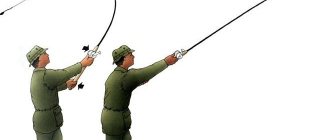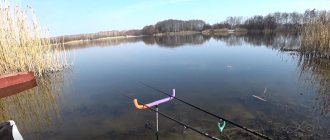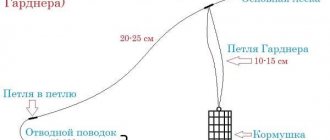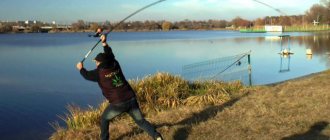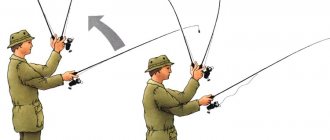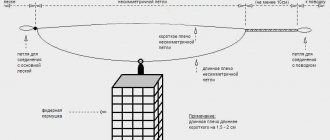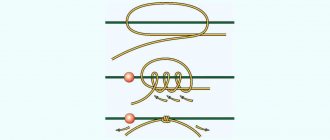Beginner fishermen sometimes do not know how to cast a feeder correctly. Transferring the experience of casting a spinning rod or a regular donkey to a feeder tackle entails shooting of the equipment, breaking of tips and even rods. Feeder fishing often occurs under conditions of maximum load on the gear due to the large weight of the feeders and the long working distance. Feeder gear is specific and requires appropriate techniques for working with it. Casting a feeder is performed slightly differently, taking into account the characteristics of fishing and equipment. In this article, we will look at the features of the technique of correctly throwing the tackle, we will analyze the key points and execution options.
The importance of accurate and correct casting
The key feature of feeder fishing is repeated throwing of gear at the same point with bait. In addition, you often have to fish at a fairly high pace. The feeder is not a donk that you cast, set and wait for a bite. The feeder equipment is often recast, even if there is no bite. This is part of the correct tactics and fishing technique. Therefore, the feeder must have a correctly set and perfect cast. More details about the features of fishing with a feeder.
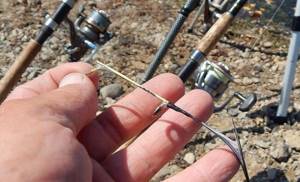
The casting distance, its accuracy, the heaviness of the feeder with bait, and the frequency of repetitions add up to a dangerous mixture of factors that increase the likelihood of damage to the equipment in case of incorrect actions. If in a spinning rod the fishing line gets caught in the ring, then nothing bad will happen - the spoon will just fall next to the fisherman, and will not fly where it was sent. With feeder equipment weighing 100 grams or more, the quivertip will simply break due to overlap. If you place the rod incorrectly, the braid at the end of the flight path of a heavy rig will come off on the clip (the so-called shooting). If the clutch is not tightened during a power long cast, the thin cord is likely to deeply cut the angler’s finger.
However, all these moments are not scary if you perform the correct technique. Feeder casting is not difficult in principle. However, the technique of its implementation requires the angler to be attentive. Over time, the fisherman will perform these nuances automatically. At the beginning of the journey, each feeder casting needs close attention. Let's look at how to throw a feeder into one place correctly, consider the nuances of the technique and various types of execution.
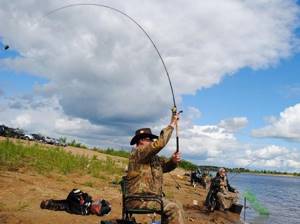
How to catch fish correctly?
Be sure to watch the video from Dmitry Salapin “Fishing landing net”, where in addition to the necessary characteristics of a landing net, the correct way to use it is described.
Do not lift the handle of the landing net with the fish up, but pull it towards you!
The handle of the landing net is quite flimsy and may not withstand the load due to its large length (large shoulder for applying force and, accordingly, a large load). Therefore, we pull the landing net towards us through the water, and lift it when our hand is at its base.
The advice seems to be optional, but in the rush of fishing, when they managed to bring out a big fish, sometimes they forget about it, trying to quickly raise the fish - as a result, a broken handle and an unnecessary breakdown.
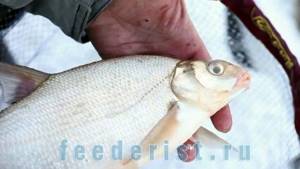
After hooking a fish, don’t rush to pull it out as fast as you can!
This is especially true when it feels like the fish is of decent size. You should keep the tackle taut and let it calm down a little. And using the pumping method (we pull up the rod, lower it and at the same time wind the reel) to bring the fish to the shore. The main thing here is calm and not to force things.
Newbie problems
Before casting the feeder, you need to eliminate the reasons that lead to the breakdown of the gear. At first, novice feeders just need to keep an eye on these points. As you gain experience on a pond (literally several fishing trips), this approach simply becomes a habit.
Why does the feeder come off when casting? Usually the equipment breaks on the clip at the end of the load's flight path. The reason is the horizontal position of the rod, with the tip directed towards the landing of the equipment. The force impulse of the flying load is not absorbed by the rod blank, but directly hits the fishing line attachment point. In addition to shooting the equipment, an even bigger problem can happen - the clip on the spool will break. To prevent this from happening, the rod after the swing, while the rig is flying, is moved to such a position that an angle is formed between the flight vector of the rig and the direction of the blank. To do this, the feeder is raised with its tip up and positioned at an angle to the surface of the water (60-70 degrees). When the entire length of the working cord is straightened, the flight impulse of the heavy rig no longer directly affects the clip, but is absorbed through the rod blank.
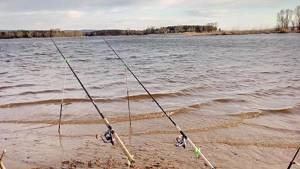
The correct position of the feeder at the moment of landing of the equipment is also important from the point of view of the accuracy of casting along the length. Therefore, at the moment of landing, the tip of the rod must be at a working distance from the fishing point in order to properly maintain the distance, up to a meter. Experienced feeders dampen inertia by not lifting the rod, but by moving it to the side, almost to the working position, just as it would be lying on the stand. In this case, an angle is also formed between the vector of the flying rig and the fishing rod, only in a different plane.
When casting forcefully, the rig can be shot off even if the cord overlaps the ring. In the worst case, it is not the braid that breaks, but the tip or ring that breaks. To prevent this from happening, the angler needs to constantly monitor the free passage of the fishing line through the guides at all stages prior to casting. I changed the bait, filled the feeder and checked. I took the tackle back and checked it again before actually swinging. This is done simply with a finger, which presses the line against the butt during the swing. By simply pressing this finger on the cord, we check with tactile sensations that the equipment moves freely along the rings and nothing interferes with it. At first, it is better to monitor this moment visually, accompanying the entire length of the cord through the feeder rings, from the reel to the overhang.
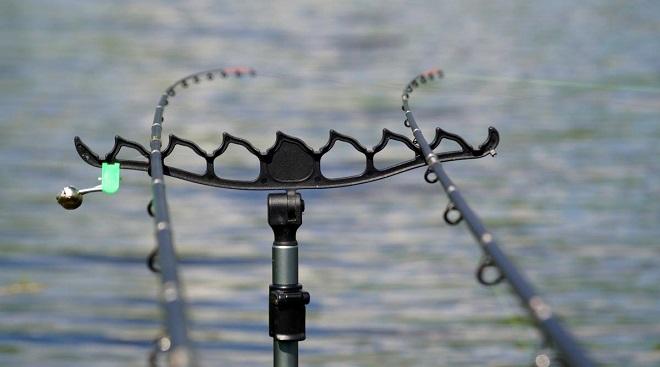
Tips from experienced anglers
For those who decide to switch to feeder fishing, you need to know the following:
- make the right choice of fishing rod, in accordance with the reservoir;
- it is necessary to use active fishing tactics, bait should be re-cast, with an interval of no more than 10 minutes;
- before fishing, it is necessary to correctly select and prepare groundbait and bait, depending on the fishing location;
- It is best to equip the tackle with one hook; using several can lead to constant tangling;
- It should be remembered that this is not a spinning bottom tackle, it is more delicate and requires a soft approach.
You can ask your question to our author:
Equipment compliance
In order not to break the rod at all, you need to equip it with a weight that does not exceed the test blank. With some experience, a good rod can throw weights much higher than the test weights. However, it is better not to do this for beginners. If the feeder is swung incorrectly or sharply with overload, the rod blank may not be able to withstand it. It is possible to make such long and heavy casts, exceeding the rod test, but only when the equipment has already been installed, at your own peril and risk. A good stick throws the weights intended for it on its own due to its properties, without the use of force. It is better to leave power throws of large weights at a distance for later - after mastering the basic technique.
The convenience of throwing is determined by the appropriate equipment. Feeder equipment is not just any reel, fishing line and working installation that comes along. Everything is selected for a reason (which is acceptable in donk), but in addition to catching fish, to ensure the possibility of long-distance and accurate casting. A certain diameter of the fishing line, bullet feeder, shock leader insert - all this affects the casting of the tackle. An article about the features of feeder equipment.
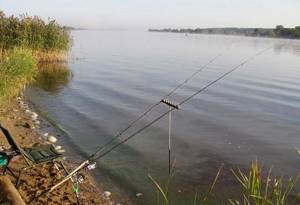
Requirements for fishing line and feeders
In the case of fishing line, the choice is quite simple - it’s definitely braided. Also, when choosing, you need to take into account that the thinner the cord, the greater the casting range, which is associated with less weight of the fishing line and reduced friction. However, when using too thin options, another problem arises - such braids break when casting heavy feeders, although this problem can be eliminated by using a shock leader.
Important! At long distances there is no point in using monofilament. It not only reduces the feeder casting range, but also, due to its stretchability, does not transmit the bite well to the tip.
Feeders that can fly as far as possible also have characteristic features. First of all, this concerns loading. Their center of gravity is shifted forward, and the feeder itself is bullet-shaped, which reduces aerodynamic drag. The weight of the feeder is also important - you shouldn’t try to throw feeders weighing less than 60 grams over long distances; you still won’t get a good casting distance.
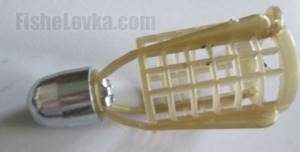
Photo 4. Long-range bullet feeder.
Important! If, however, there is a clear mistake, then the feeder must be emptied of food in the upper layers of the water. This way the feeding spot will not stretch, and bait near the surface will distract small white fish.
The selected version of the feeder equipment does not have a significant impact on the casting distance; you can choose based on personal preferences and the characteristics of the fishing conditions.
Feeder casts
Casting a feeder cannot be done according to the canons of a spinning rod or donkey - the force effects on the tackle are much greater, which leads to breakdowns if the technique is incorrect. Spinning allows sharp swings, since the baits are relatively light. Donochers have short rods. The load in the feeder is large, and the rod is long. As a result, the force impact during casting increases many times (according to the laws of physics). Therefore, the technique of casting a feeder is not a shot (as on a spinning rod), but rather a catapult - a sweeping acceleration of the weight of the equipment and sending it in the desired direction. Sharp, biting jerks are unacceptable. Feeder casting of the tackle is a strong, but soft and sweeping movement. The lighter the rig and the shorter the rod, the more abrupt movements are allowed. Understanding this will come with experience when using feeders of various calibers. Read more about feeder gear.

Casting technique
Almost all feeder casts are based on the same technique. In this article we will take a closer look at the standard cast, from the top position from behind the head. More complex pendulum or English (match casting) are basically the same, just some aspects of tackle control are omitted. Such options are used for tempo fishing, when the main technique is absolutely established.
At first, every long cast with a feeder requires attention from the angler at every step. To correctly cast a feeder with a feeder in the absence of experience working with bottom gear, you should practice with a simple weight. The weight of the weight depends on the test of the rod. We clip the braid, for example, at 40 meters. To do this, we unwind the fishing line (possibly on pegs), measuring the required distance, and insert the braid into the spool clip. At the initial stages, it is better to clip with an elastic band. Article about clipping the feeder.
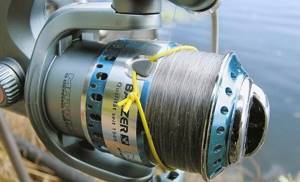
- We wind the coil, forming an overhang of about 1 meter. Some anglers prefer a shorter overhang - about 60-70 centimeters. The rod is positioned forward and upward from the angler, at an angle of 45-60 degrees.
- The position of the hand on the butt depends on whether the person is left-handed or right-handed. Consider the base case - right-handed. Left-handed people do the same thing, just changing their right hand to their left. So, with our right hand we hold the butt in the area of the reel so that the spindle leg passes between the fingers, usually the index and ring fingers. The thumb rests on top of the butt, the index finger controls the line coming out of the spool. At this stage, we control the absence of overlap by pressing and releasing the cord to the butt with the index finger. At the same time, we tactilely feel the free movement of the equipment. You need to make sure that nothing gets caught anywhere. Additionally, we check this point visually, tracing the entire length of the cord through the rings.
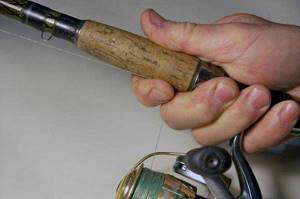
- We tighten the clutch - otherwise, when casting forcefully, the cord will slip through and cut your finger like a saw.
- We remove the line laying arm. The reel should be in such a position that the line guide is parallel to the ground, and not perpendicular. Otherwise, it may slam shut during the casting stroke, and the load on the knot will be shot off.
- Straighten your arm, lift the feeder and bring it back, behind your head. In this case, the reel ends up upside down on top of the rod. The rod is positioned at an angle of 30-45 degrees to the ground. With the other hand we grab the butt of the feeder. This way the rod faces backwards, upside down, with your arms extended above your head. At first, casting should be done while standing – it’s easier this way. Then, with experience, you will be able to perform all the manipulations while sitting.
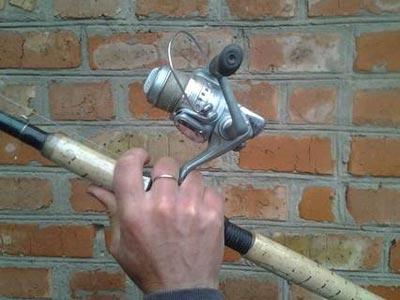
- This is the initial position of the feeder before casting. Once again, check the free movement of the cord with your finger to ensure there is no overlap. You can look back and inspect the equipment visually. This is Fadeev’s so-called looking cast.
- Let's cast. We aim at a landmark, matching it with the hand holding the rod by the butt. We make a soft swing with acceleration. When the rod passes overhead and slightly forward, we release our finger from the cord. The load flies in a given direction for a number of seconds, depending on the range.
- While the load is flying, we place the feeder in front of us with the tip up at an angle of approximately 60 degrees - for shock absorption. When the flying load reaches the entire length to the clip, the blank with its elasticity will stop the flight, and the equipment will fall into the water at the selected distance. In this case, there will be a slight jerk of the rod in the direction of casting and a characteristic sound of the line hitting the clip.
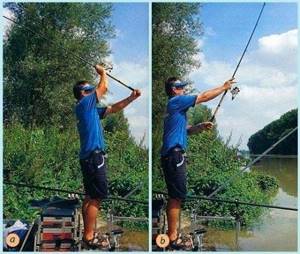
It is better to train on a monofilament line with a diameter of about 22 mm. The monofilament stretches, adding elasticity to the system, which further protects the tackle from breakage in case of an error. Usually an hour or two on a pond is enough for a person to learn how to cast a feeder correctly, even if he has never fished before.
Casting Variations
When the basic cast is mastered, you can adopt its variations - pendulum or English cast. This can be done when the anti-twist control is already automatic, and the angler literally feels the gear. In principle, the pendulum cast of the feeder is the same, the control stages are simply skipped before moving the tackle back and before the swing. This saves time, which is important for sports feeder fishing. After changing the bait and hammering in the bait, the equipment is moved forward. At the same time, the fisherman intuitively feels that everything is fine with the equipment and it has not overlapped. The tackle is wound back (observing the grip characteristics) and immediately thrown.
The English cast is performed in the same way as when fishing with match gear. The technique is the same as for the pendulum. The difference is the large overhang of the working part, reaching almost to the coil. This method is very accurate and fast when fishing at pace at a short distance. When shortening the overhang, time for winding is removed from the complex of movements. It is recommended to do it only by experienced feeders.
Casting the feeder from under you is like a nearby spinning pendulum. The rig seems to swing out from under itself by moving the rod forward and upward. This type of casting allows you to throw the equipment close, up to 20 meters. However, it is indispensable on reservoirs when bushes and trees behind the angler do not allow standard casting.
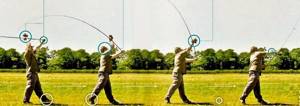
Power throw
A power cast is performed in exactly the same way as a standard cast, only with the investment of force. Such casting is necessary for launching heavy equipment over long distances. Walking also allows you to increase your force input. To do this, the swing is carried out when the left leg steps forward, which adds the inertia of the fisherman’s body to the force impulse. Power swings must be performed especially carefully - any mistake will lead to shooting or failure in 100% of cases of error. It is recommended to use a special feeder fingertip. If the clutch slips, the finger will be cut by the braid. Equipment for heavy loads must have a feeder shock leader. It is not recommended for a beginner to start heavy casting until the standard technique has been mastered.
Selection of gear for beginners
The best option for configuring feeder tackle for beginners would be to purchase a ready-made set. It includes all the necessary elements of bottom gear:
- feeder rod
- reel
- fishing line
- installation
- hooks
- feeders
- stand
Fishing store consultants will help a novice fisherman choose the optimal set. If this is not possible, then we independently select the elements of equipment for the medium rod. This video explains in detail how to choose a feeder for beginners:
The reel for the fishing rod is selected taking into account the fishing distance and the type of cord. The best option for beginners are models with a spool size of 3000, adapted for fishing with thin braided lines.
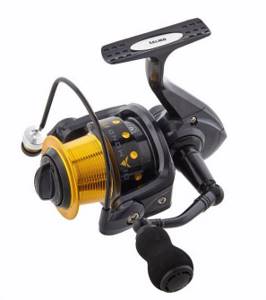
Many of them indicate that these are feeder coils. In the store, it is important to check its progress and the operation of the clutch. The weight of the reel should not exceed the weight of the rod. It is very important that the kit includes a spare spool. When fishing, sometimes you have to change the type of line.
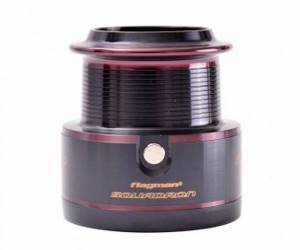
Beginner feeders often ask the question: “Which is better to choose fishing line or braid?” It is optimal to buy both fishing line and braid. If you fish at a distance of more than 35 meters, then we definitely use a braided cord with a cross-section of 0.1-0.14 mm, depending on the object of fishing.
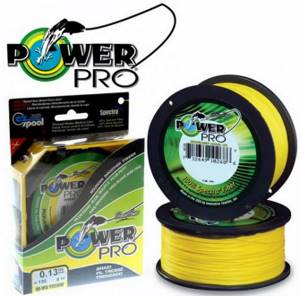
If fishing is carried out at close range, then fishing line and cord are equally suitable. When fishing in specific conditions - in sub-zero temperatures or during periods of mass accumulation of fluff on the surface of the water, a fishing line is used. Its diameter varies from 0.18 to 0.25 mm. Beginners can be offered models with a cross section of 0.23 mm. The fishing line should not have memory and not lose strength at the knots.
Feeder feeders vary in weight, volume, shape, and the material from which they are made. The main criterion for selecting feeders is the strength of the current at the fishing site. The fisherman’s task is to choose a feeder that would lie on the surface of the bottom and not be carried away by the current.

How can a novice fisherman check whether the feeder is being carried by the current or not? After casting, the feeder is installed on the stand and the behavior of the tip is observed. If it stands still, then the feeder is “caught on the bottom.” If the tip bends smoothly with the same frequency, then the feeder is carried by the current. Install a heavier one. For beginners, we can recommend bullet feeders with a plastic body:
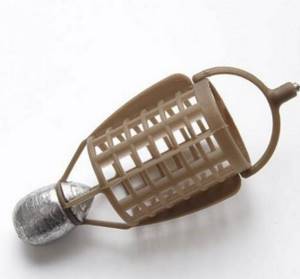
With this model it is easy to make accurate casts even in windy weather. When reeling out the gear, the feeder quickly floats up and does not cling to bottom obstacles and grass.
Hooks and leaders are the most important elements of equipment. For catching medium-sized fish, it is optimal to use hooks No. 12-14 according to international numbering. For plant baits, hooks with a short shank length are used. For the worm, models with long forends are used. When fishing with bloodworms and maggots, preference is given to models made of thin wire. Among the manufacturers we can recommend Ovner, Dekoy, Gamakatsu.
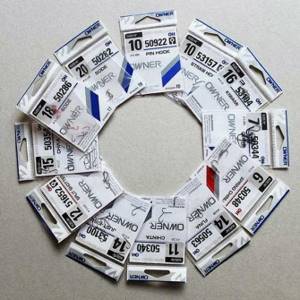
The main criterion when choosing fishing hooks is sharpness. Remember that a sharp hook will significantly increase the number of successful hooks.
The simplest and most reliable feeder installation for beginners is a paternoster.
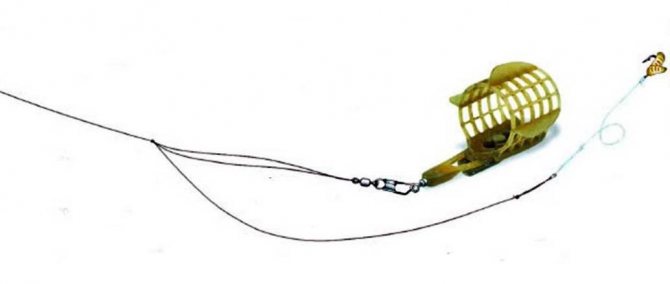
It literally takes one minute to knit as follows:
The length of the leash is selected depending on the strength of the current. When fishing on reservoirs without a current or with minimal water movement, leashes with a length of 20 to 40 cm are preferred. On rivers with a current, leashes with a length of 40 to 70 cm are more often used. For passive biting, leashes from 1 to 2 meters are used. The line diameter varies from 0.08 to 0.16 mm depending on the activity of the fish. The worse the bite, the thinner the leash.
Feeder fishing requires many other accessories. A novice feeder will need an extractor, a rod stand, a chair, a landing net and a cage.

Feeder casting accuracy
It is correct to cast a feeder with a feeder in still water, on a current, and in general in any conditions - place the installation at the same point. It is believed that the feeder, even at long distances, should fall within a square meter of area. To cast the feeder correctly, you need to set a certain working length by clipping, and always place the rod in the same position when splashing down the feeder, so that there is no error in length. Aiming in azimuth is carried out visually. To do this, a fixed landmark is selected on the opposite bank - a tree, a building, a fold of the bank, etc. When casting, aiming is carried out at this landmark. For accuracy during the starting position, you need to compare your hand on the butt of the feeder with a landmark in the line of sight. With experience, this moment happens automatically. Constantly throwing the feeder into the same place on the feeding point is the main goal, a feature of the tactics, in contrast to donks.
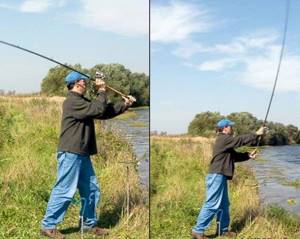
First way
By far the most popular method is using an elastic band.
This casting restriction is done very simply:
- After casting and determining the optimal fishing distance, we place the feeder on the stand and slightly tighten the line so that the feeder tip is in a bent, taut position.
- We take an elastic band (most often they use a bank rubber band, a stationery rubber band, or any other suitable and durable one) and put it on the spool, making two or three turns. The rubber tension should be strong;
- We insert one turn of elastic into the clip;
- When unwinding the cord or fishing line, the rubber will remain under the coils. And after casting it limits the range. Do not forget that during casting it is better to move the feeder to a vertical position, this will weaken the jerk and contribute to less load on the rubber.
The disadvantage of this method is the inability to use the clutch immediately after hooking a large fish. If you are catching bream, crucian carp or small carp, then this is not so important, but if there is a high probability of catching good specimens weighing several kilograms, then this is already a significant drawback. If such a long-awaited moment has finally arrived, then the main thing is not to fuss!
- The most correct thing at such a moment would be to be directly next to the feeder (as it should be in feeder fishing), in this case the rod is picked up and moved towards the fish. That is, you need to try to loosen the tension of the fishing line, and sometimes you have to enter the water. At this stage, we can absorb the jerks of the fish only with the help of a feeder, the position of which is close to vertical. It is precisely in this case that feeder rubber in the equipment or monofilament as a base can help us with depreciation.
- If you feel that there is truly a “monster” at the other end of the fishing line, which is about to tear the leash to the famous grandmother, then with your free hand we find our elastic on the spool and tear it or tear it out of the clip. The clutch immediately starts working, which should already be set to a resistance slightly greater than what the feeder with bait creates.
In order to find our bait point again in the event of a break in the elastic band or loss of equipment, we need to “ duplicate ” the fishing distance in advance. Most often this is done like this:
- After finding the optimal casting distance, when the rig is cast, the braid in front of the reel can be marked with a marker;
- After fixing with an elastic band, wind up the fishing line and unwind it on the shore, noting its length on objects (suitable if the shore is relatively empty and the fishing distance is short);
- In any case, for accuracy, while pulling up the feeder equipment, we count the number of revolutions of the coil. This method will also help in the future if fishing takes place in the same area of the reservoir.
As you can see, the method is not complicated, and its only drawback is problems with landing large fish. And in this case, it would be better to use fishing line as a base (if possible) and feeder rubber in the equipment to absorb the jerks of the fish.
The second method
A less common method of fixing the casting distance, I used it before until I learned about the first fixation option.
The main difference between this method and the previous one is the use of a cut elastic band, that is, you can use a torn bank one or any suitable one.
- After finding the optimal fishing range, we make a ring of elastic around the main fishing line. The ring should be small, about a centimeter in diameter;
- Tighten the rubber ring well and cut off the ends from the knitting;
- We move the ring towards the reel and fix it in the clip.
After casting, the distance is also well fixed, but do not forget to raise the feeder up before splashing down the feeder.
advantage over the first method - it is easier to find the ring by hand and tear it out of the clip, if necessary.
But disadvantages in this method:
- The same impossibility of releasing the fishing line after catching a large fish;
- Extra time for knitting a ring;
- A knot that slightly disrupts the order of the turns of braided line on the spool.
But, despite the shortcomings, you also need to know about this method of fixation; in some conditions it can be useful for a feeder lover or any fisherman.
Feeder casting range
The normal operating distance of the feeder is up to 90 meters. If you try, you can throw it further (if you have the appropriate gear and skill for this). The peculiarity of feeder tactics is tempo fishing, constant recasts. It is physically impossible to fish for a long time, constantly casting 100 meters and reeling in a heavy load. In addition, bites at such a length are practically undetectable. You can only work on your own.
The flat feeder allows you to cast even further – up to 120 meters. In this setup, catching makes sense. The tempo of the flat method is low. Therefore, such a range may be advisable. Even greater distances can be used when fishing for large carp with fishing rods specially equipped for this purpose. In carp fishing, the tackle is installed, and in anticipation of a bite, it can stand in this position for many hours before the bite. Sometimes carp anglers bring equipment on boats to bait points, and wait for a bite on the shore. But this is no longer standard feeder fishing. The usual working distance for a comfortable pace of fishing and casting is up to 80 meters. At 90-100 meters, fishing is already much more difficult physically and technically. A finely tuned feeder is required for long-distance casting, and control of the equipment with each casting. And even this is not a guarantee of shooting a heavy feeder.

The other side of the coin is the obvious blurring of the feeding point. At such a distance it is impossible to place food at one point over and over again. The error is up to several meters. It is not a feeding point that is formed, but an extensive spot weakly saturated with bait. The main tactical meaning of feeder fishing is lost. It is better to look for a promising point closer - at least 70-80 meters. More details - breaking through the bottom with a feeder before fishing.
It is possible to make a long cast with a feeder, the question is whether it is advisable. The further the better approach does not work here. The main thing is to find the point and constantly feed it. To cast a feeder far, you need ideal tackle designed for this purpose, and such fishing rods are quite expensive. One cast per hundred square meters can be done with budget equipment, if you try. However, with a hundred such casts, something will definitely happen that will lead to breakage or shooting of the equipment. Therefore, long-distance casting does not mean overloads of 100+ meters, but the longest distances that do not leave the comfortable fishing zone (70-80 meters). Throwing the feeder correctly at such a distance and fishing on it is not difficult, provided the correct equipment and equipment are installed. This is the standard operating distance on large rivers and reservoirs.
